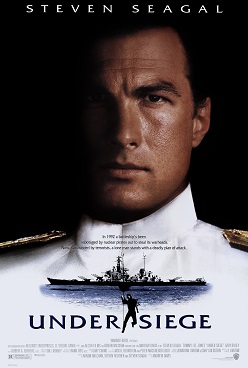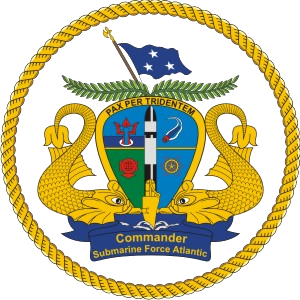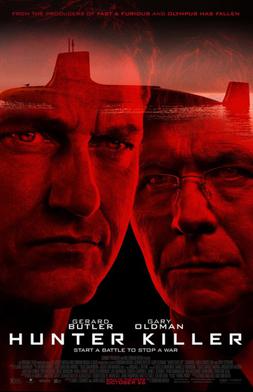
The Los Angeles class of submarines are nuclear-powered fast attack submarines (SSN) in service with the United States Navy. Also known as the 688 class after the hull number of lead vessel USS Los Angeles (SSN-688), 62 were built from 1972 to 1996, the latter 23 to an improved 688i standard. As of 2024, 24 of the Los Angeles class remain in commission—more than any other class in the world—and they account for almost half of the U.S. Navy's 50 fast attack submarines.

The Seawolf class is a class of nuclear-powered, fast attack submarines (SSN) in service with the United States Navy. The class was the intended successor to the Los Angeles class, and design work began in 1983. A fleet of 29 submarines was to be built over a ten-year period, but that was reduced to 12 submarines. The end of the Cold War and budget constraints led to the cancellation of any further additions to the fleet in 1995, leaving the Seawolf class limited to just three boats. This, in turn, led to the design of the smaller Virginia class. The Seawolf class cost about $3 billion per unit, making it the most expensive United States Navy fast attack submarine and second most expensive submarine ever, after the French Triomphant-class nuclear-powered ballistic missile submarines.

Under Siege is a 1992 action thriller film directed by Andrew Davis from a screenplay by J. F. Lawton. It stars Steven Seagal, Tommy Lee Jones, Gary Busey, and Erika Eleniak. Seagal plays Casey Ryback, a former Navy SEAL, who must fend off a group of mercenaries after they commandeer the U.S. Navy battleship Missouri.

USS Scorpion (SSN-589) was a Skipjack-class nuclear-powered submarine that served in the United States Navy, and the sixth vessel, and second submarine, of the U.S. Navy to carry that name.

Richard Hetherington O'Kane was a United States Navy submarine commander in World War II, who was awarded the Medal of Honor for commanding USS Tang in the Pacific War against Japan to the most successful record of any United States submarine ever. He also received three Navy Crosses and three Silver Stars, for a total of seven awards of the United States military's three highest decorations for valor in combat. Before commanding Tang, O'Kane served in the highly successful USS Wahoo as executive officer and approach officer under noted Commander Dudley "Mush" Morton. In his ten combat patrols, five in Wahoo and five commanding Tang, O'Kane participated in more successful attacks on Japanese shipping than any other submarine officer during the war.

USS Shark (SS-314), a Balao-class submarine, was the sixth ship of the United States Navy to be named for the shark, a large marine predator.

Charles Bowers Momsen, nicknamed "Swede", was born in Flushing, New York. He was an American pioneer in submarine rescue for the United States Navy, and he invented the underwater escape device later called the "Momsen lung", for which he received the Navy Distinguished Service Medal in 1929. In May 1939, Momsen directed the rescue of the crew of Squalus (SS-192).

USS Virginia (SSN-774) is a nuclear powered cruise missile attack submarine and the lead ship of her class, currently serving in the United States Navy (USN). She is the tenth vessel of the Navy to be named for the Commonwealth of Virginia, as well as the second US Navy attack submarine to be named after a state, a pattern that is common throughout her class.

The submarine film is a subgenre of war film in which most of the plot revolves around a submarine below the ocean's surface. Films of this subgenre typically focus on a small but determined crew of submariners battling against enemy submarines or submarine-hunter ships, or against other problems ranging from disputes amongst the crew, threats of mutiny, life-threatening mechanical breakdowns, or the daily difficulties of living on a submarine.

USS Hyman G. Rickover (SSN-709), a Los Angeles-class submarine, was the first ship of the United States Navy to be named for Admiral Hyman G. Rickover, pioneer of the nuclear Navy, and the only Los Angeles-class submarine not named after a United States city or town. She was initially to be named USS Providence; however, following the retirement of Admiral Rickover, her name was reassigned prior to official christening. SSN-719 was later given the name USS Providence.
There are three major types of submarines in the United States Navy: ballistic missile submarines, attack submarines, and cruise missile submarines. All submarines currently in the U.S. Navy are nuclear-powered. Ballistic missile submarines have a single strategic mission of carrying nuclear submarine-launched ballistic missiles. Attack submarines have several tactical missions, including sinking ships and subs, launching cruise missiles, and gathering intelligence. Cruise missile submarines perform many of the same missions as attack submarines, but with a focus on their ability to carry and launch larger quantities of cruise missiles than typical attack submarines.

Charles Butler McVay III was an American naval officer and the commanding officer of the cruiser USS Indianapolis which was lost in action in 1945, resulting in a significant loss of life. Of all captains in the history of the United States Navy, he is the only one subjected to court-martial for losing a ship sunk by an act of war, despite the fact that he was on a top secret mission maintaining radio silence.

The Commander, Naval Submarine Forces is the Submarine Force U.S. Atlantic Fleet type commander under the United States Fleet Forces Command.

The Commander, Submarine Force, U.S. Pacific Fleet (COMSUBPAC) is the principal advisor to the Commander, United States Pacific Fleet (COMPACFLT) for submarine matters. The Pacific Submarine Force (SUBPAC) includes attack, ballistic missile and auxiliary submarines, submarine tenders, floating submarine docks, deep submergence vehicles and submarine rescue vehicles throughout the Pacific.

The McCann Submarine Rescue Chamber is a device for rescuing submariners from a submarine that is unable to surface.
Submarine Squadron 10 was a unit of the United States Navy during World War II in the Pacific and in the Atlantic Fleet after the war from 1951–1991. The number and type of submarines assigned to SUBRON 10 varied throughout its history.
Project Nobska was a 1956 summer study on anti-submarine warfare (ASW) for the United States Navy ordered by Chief of Naval Operations Admiral Arleigh Burke. It is also referred to as the Nobska Study, named for its location on Nobska Point near the Woods Hole Oceanographic Institution (WHOI) on Cape Cod, Massachusetts. The focus was on the ASW implications of nuclear submarines, particularly on new technologies to defend against them. The study was coordinated by the Committee on Undersea Warfare (CUW) of the National Academy of Sciences (NAS). It was notable for including 73 representatives from numerous organizations involved in submarine design, submarine-related fields, and weapons design, including senior scientists from the Atomic Energy Commission's nuclear weapons laboratories. Among the participants were Nobel laureate Isidor Rabi, Paul Nitze, and Edward Teller. The study's recommendations influenced all subsequent US Navy submarine designs, as well as submarine-launched ASW tactical nuclear weapons until this weapon type was phased out in the late 1980s. New lightweight and heavyweight anti-submarine torpedo programs were approved. Although not on the initial agenda, the Polaris submarine-launched ballistic missile (SLBM) was determined to be capable of implementation at this conference. Within five years Polaris would dramatically improve the US Navy's strategic nuclear deterrent capability.

Hunter Killer is a 2018 American action thriller film directed by Donovan Marsh, written by Arne Schmidt and Jamie Moss, and based on the 2012 novel Firing Point by Don Keith and George Wallace. The film stars Gerard Butler and Gary Oldman with Michael Nyqvist, Common, Linda Cardellini and Toby Stephens in supporting roles, and follows a submarine crew and a group of United States Navy SEALs who rescue the captured Russian President from a coup.
Submarine rescue is the process of locating a sunk submarine with survivors on board, and bringing the survivors to safety. This may be done by recovering the vessel to the surface first, or by transferring the trapped personnel to a rescue bell or deep-submergence rescue vehicle to bring them to the surface. Submarine rescue may be done at pressures between ambient at depth, and sea level atmospheric pressure, depending on the condition of the distressed vessel and the equipment used for the rescue. Self-rescue of submarine personnel by buoyant free ascent at ambient pressure is considered submarine escape. Survivors may require recompression treatment for decompression illness.















